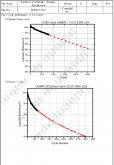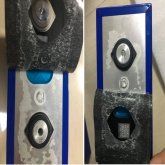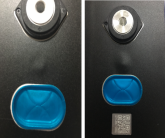Probably not, my is Visa
The common denominator seems to be Capital One. They issue MC and VISA cards.
Probably not, my is Visa


My Chinglish Translator can't manage everything. I find some of the stuff a bit erroneous because It is so poorly translated. You would think they would have English Speakers, Reader's / Writers at least verify the translation to make sure it makes sense. I just pass along the info as was provided, I am JUST A CUSTOMER sharing info, details to try and help fellow Solar Adventurers.Steve, I read through the EVE LF280 Spec Sheet that you posted on Thursday, and there is one part of it where I just don't understand what they are talking about. In the table portion, they have this information on cycle life:
---
I think there is a misprint, and one is supposed to be (Without fixture) and the other (With Fixture), but the cycle life difference is significant. It seems they are talking about the clamping pressure the cells are under, but I'm just guessing. 300kgf seems like a lot of pressure.
---
Later in the same specification document, in the graphs and charts section, they have this page:
---
Once again talking about with or without 'Fixture'. I'm guessing that perhaps the black line is actual test data and the red is projected life? Anyway, they show that with fixture initially drops in capacity more quickly, but then takes 1500 more cycles to get down to 80% capacity. Does anyone have any idea what a 'Fixture' is or how they intend 300kcf of force to be applied to the cell? The google machine has been of little help so far in trying to answer this question.
There was a post on one of the battery threads about someone who stripped a terminal, HeliCoiled it, and bought stainless studs to replace the bolts. He posted pics and a link to the studs. I've gone back and looked, but haven't found his post and I don't remember which thread it was in.My 280Ah LFP cells arrived today! Right on schedule... per Amy's 10 day ETA.
Yesterday, there was no tracking update except pending. Then this morning I received a text from Fedex that they were out for delivery. And then a new text that they were delivered!
I opened the package. The cells were very well packed, two nested heavy cardboard boxes with thick foam wrapping each individual cell. A+ for packing.
I tested voltage with my Fluke. All 4 tested @ 3.290 V.
Came with M6 terminal bolts and large pack of busbars. I might swap the terminal bolts for stainless vs. mild steel with yellow zinc coating. We'll see.
Very happy so far!
Doug
Steve, I read through the EVE LF280 Spec Sheet that you posted on Thursday, and there is one part of it where I just don't understand what they are talking about. In the table portion, they have this information on cycle life:
View attachment 8282
I think there is a misprint, and one is supposed to be (Without fixture) and the other (With Fixture), but the cycle life difference is significant. It seems they are talking about the clamping pressure the cells are under, but I'm just guessing. 300kgf seems like a lot of pressure.
Later in the same specification document, in the graphs and charts section, they have this page:
View attachment 8283
Once again talking about with or without 'Fixture'. I'm guessing that perhaps the black line is actual test data and the red is projected life? Anyway, they show that with fixture initially drops in capacity more quickly, but then takes 1500 more cycles to get down to 80% capacity. Does anyone have any idea what a 'Fixture' is or how they intend 300kcf of force to be applied to the cell? The google machine has been of little help so far in trying to answer this question.
My 280Ah LFP cells arrived today! Right on schedule... per Amy's 10 day ETA.
Yesterday, there was no tracking update except pending. Then this morning I received a text from Fedex that they were out for delivery. And then a new text that they were delivered!
I opened the package. The cells were very well packed, two nested heavy cardboard boxes with thick foam wrapping each individual cell. A+ for packing.
I tested voltage with my Fluke. All 4 tested @ 3.290 V.
Came with M6 terminal bolts and large pack of busbars. I might swap the terminal bolts for stainless vs. mild steel with yellow zinc coating. We'll see.
Very happy so far!
Doug
My 280Ah LFP cells arrived today! Right on schedule... per Amy's 10 day ETA.
Yesterday, there was no tracking update except pending. Then this morning I received a text from Fedex that they were out for delivery. And then a new text that they were delivered!
I opened the package. The cells were very well packed, two nested heavy cardboard boxes with thick foam wrapping each individual cell. A+ for packing.
I tested voltage with my Fluke. All 4 tested @ 3.290 V.
Came with M6 terminal bolts and large pack of busbars. I might swap the terminal bolts for stainless vs. mild steel with yellow zinc coating. We'll see.
Very happy so far!
Doug
The bolts don't conduct much at. It is the top of terminal in contact with what is attached to the terminal that conducts the amperage.Nice,
How do they look and feel?
Solid and durable? And can you tell if the terminals are solid, or is it possible to 'wiggle' the bolts around a bit?
Those, and the quality / real cycle life vs stated on specs are my biggest doubts about ordering. Together with the m6 bolts. Are these big enough for conducting 200amps all at once?
Look at the side terminal batteries that GM used. There is a large ring on the battery and the cable that mates with it. The bolt is just there to hold the 2 parts together and in contact with each other. The bolt on a clamp style car battery lug, just squeezes the lug to the terminal.As Sgt Raven points out, the bolt is not the main contact, it's the bus bar to the cell post top that counts the most. It's common to think the bolt is more important but that is a partial left over of how people think of Car Batteries with their post & clamp type connections, people associate the bolt being the "post" as such.


Hi Patrick,Nice,
How do they look and feel?
Solid and durable? And can you tell if the terminals are solid, or is it possible to 'wiggle' the bolts around a bit?
Those, and the quality / real cycle life vs stated on specs are my biggest doubts about ordering. Together with the m6 bolts. Are these big enough for conducting 200amps all at once?
Hi Patrick,
I'm not sure visible inspection would reveal too much. But, they look fresh and new. And were very carefully packed, which I appreciate.
Based on what I've seen, I'd buy again.
As others stated, the bolt is to clamp, not conduct. My sense is this should work OK. Since I'll be clamping heavy 4/0 cables to each of the battery's end terminals, I will find a way to isolate vibrations and stress.
I'll probably add an adel clamp for each to the plastic housing I'm making.
I won't be able to load test until they are in situ. I'll use my Magnum inverter and loads like a heat gun.
Cheers, Doug


Hopefully they don't send you 280AH cells!These are 4x 105Ah cells. They do look thicker than I expected from the product pages.


